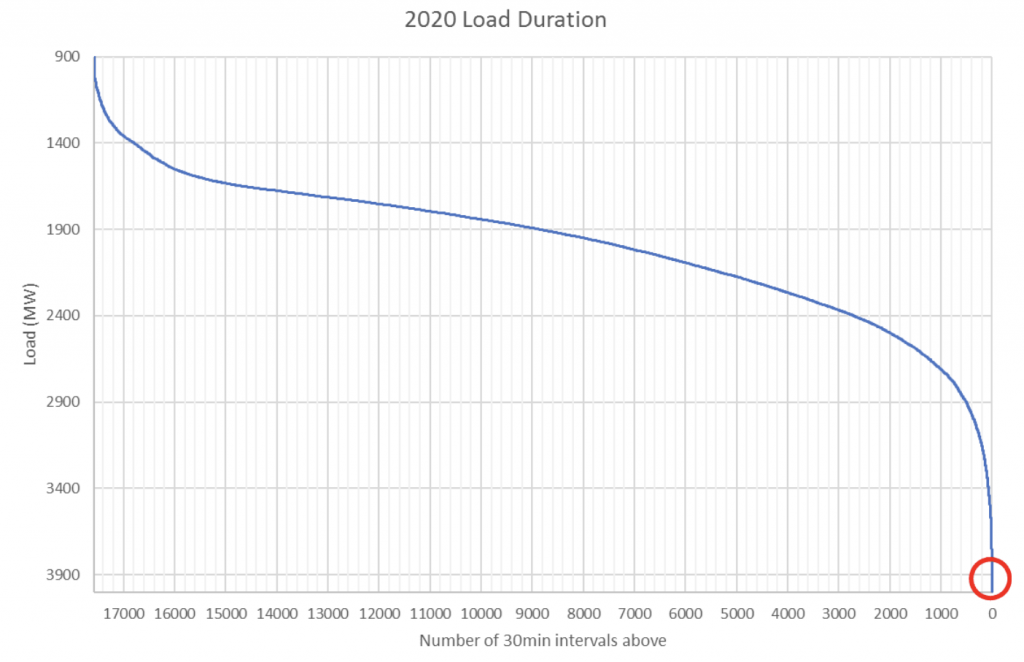Understanding the electricity capacity charge
Electricity Capacity Charge? That’s a rip off, right?
The capacity charge in our network is often misunderstood as it can be a pretty opaque concept. Hopefully we can explain why it’s there, how it all works and how you can game it to reduce your cost.
Getting up to speed
Australian networks are summer peaking grids. This means that we use a lot more energy in summer than we do during any other time of year as we are very temperature dependant. How nice is it coming home from work on a 40-degree day and setting the air conditioner to 18 degrees? Our propensity to do this is what makes us temperature dependant.
Put simply, for most of the loads in our network there is a strong positive correlation between temperature and electricity demand.
Okay, but what does this mean for me?
Well, electricity is an odd commodity. At all times supply must equal demand. To ensure you can come home during the peak of summer and turn your air conditioner on, we have to have the generation capacity sitting there all year round. If we can’t meet that summer peak, we’ve got big issues! God forbid the beer gets warm…
Looking at this on a graph might make it a bit easier to see:

Down in the bottom right corner, it shows that for just one (1) 30-minute period of 2020 we needed 3,970MW of generation. As we’ve said above, it doesn’t matter how long you need it, you’ve got to have all of that generation there ready to meet the demand.
So why would someone spend millions on a generator to potentially only run it for half an hour a year? That’s where electricity markets come in!
Electricity Markets Overview
Electricity markets can seem complex but fundamentally there are two types of electricity market:
- Energy only markets
- Capacity markets
You might have heard of some pretty crazy prices over in the Eastern states. That’s because the (not so) National Electricity Market is an energy only market. This means that to entice people to build a generator (that might only run for half an hour a year) there are effectively no wholesale energy price caps ($15,000/MW). The risk of prices getting to these elevated levels gets priced into a consumer’s energy rates or the retailer reserves the right to pass through penalties.
The WA Wholesale Electricity Market is a capacity market. This means that we’ve got pretty low energy price caps (~$350/MW) however we also have capacity payments (as the name would suggest). WA can’t import electricity from another state so to ensure we’ve got enough generation capacity to meet the peak demand, available capacity receives a fixed monthly payment. This payment is based on the size of the generator, how much capacity we need and how much excess capacity we’ve got. This provides investment signals to the market and ensures the market operates efficiently.
How is the capacity market funded?
The capacity market is funded through the capacity charge.
Every meter has a capacity charge, and this is based on the meter’s contribution to peak demand. This mechanism distributes the cost of having generation on standby all year round to consumers based on their share of that peak requirement.
The AEMO selects the four highest demand days from the hot season (December – March) and they look at the highest 1.5 hours on each of those days. Your consumption during the six hour period (four 1.5 hour periods) is then used to calculate your contribution.
Sounds fair, right? You pay for what you use.
How to reduce your capacity charge
We call reducing the electricity capacity charge “peak shaving”. That’s because you’re looking to shave your consumption during peak periods. Simple, right?
It can be a little harder than it sounds as you’ve got to forecast when these peak periods will occur. In recent years it’s been getting harder and harder as more consumers have been getting in on the peak shaving fun.
One of the other difficult factors is solar PV generation. We’ve got almost 1.4 gigawatt (GW) of rooftop solar in the network. This has pushed peak intervals from 2PM in the afternoon to 6PM. It’s also made cloudy days the ones to look out for. The cloud cover reduces solar output and if you combine this with a 35-degree day, you’ve got a lot of load on the network.
When peak shaving is done correctly, you are essentially reducing your overall cost of supply. For customers on “unbundled” tariffs, this means your pass-through costs are directly affected. For customers on “bundled” tariffs, retailers will reflect the reduction in the cost of supply when recontracting (reduced rates).
How can Amanda Energy help?
Amanda’s analysts forecast grid demand and calculate the percentage risk of a peak occurring on any given day. The forecasts and advice are provided to the customers that have opted into our peak shaving program.
Why worry about the weather and peak demand when we can do that for you?
In order to be involved, you need to be an Amanda Energy customer and have some ability to reduce your business’ electricity consumption during late afternoons in summer.
If you are interested, why don’t you get in contact and we can have a chat about what this will look like for you. The Amanda Energy team can be reached at (08) 9430 7048.
